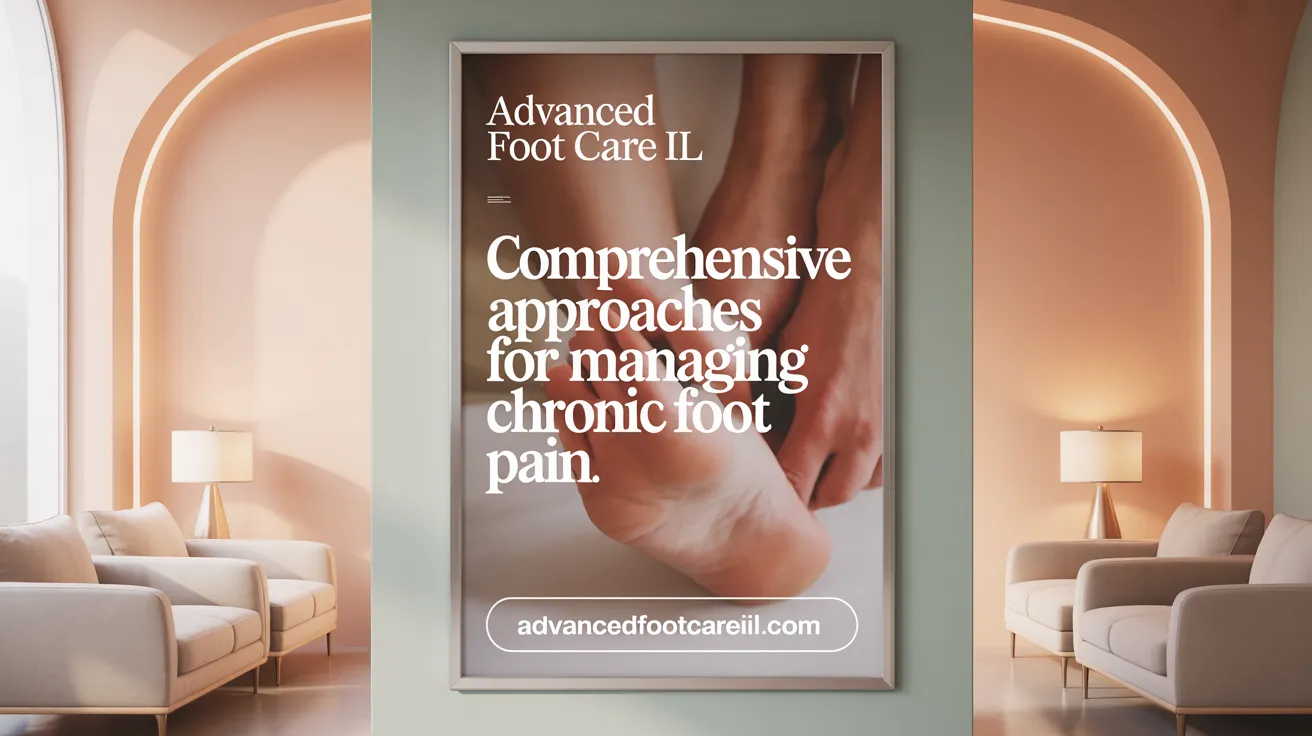Understanding Chronic Foot Pain and Its Impact
Chronic foot pain afflicts millions worldwide, significantly impacting mobility and quality of life, especially among the over-50 population. This pain arises from a multitude of causes including mechanical issues, inflammatory conditions, nerve damage, and degenerative diseases. Recognizing symptoms early, understanding prevention measures, and embracing advanced management strategies are essential steps to regain comfort and functionality. This article explores innovative and comprehensive methods to effectively manage chronic foot pain, combining traditional insights with cutting-edge therapeutic advances.
Root Causes, Symptoms, and Prevention of Chronic Foot Pain

What causes chronic foot pain, what are its symptoms, and how can it be prevented and treated?
Chronic foot pain can develop from a variety of underlying conditions. Common causes include plantar fasciitis, arthritis, nerve damage, tendinitis, bunions, gout, stress fractures, and neuromas. These issues are often triggered by injury, overuse, ill-fitting shoes, excess weight, or the natural aging process.
The symptoms associated with chronic foot problems vary based on the specific condition. They may include persistent and dull or sharp pain, swelling, stiffness, difficulty walking or standing for long periods, tingling, numbness, or burning sensations. For example, plantar fasciitis typically causes heel pain especially during first steps in the morning, while neuromas often produce burning or tingling in the ball of the foot.
Preventive measures are vital in reducing the risk of developing foot pain. Using supportive footwear with good arch support and a wide toe box helps prevent deformities and pressure points. Maintaining a healthy weight decreases stress on the feet, while regular stretching and strengthening exercises improve flexibility. Avoiding prolonged standing and overuse, along with proper foot hygiene, can further reduce risks.
Early detection and diagnosis are important to address the problem promptly. Persistent foot pain lasting more than two weeks should prompt consultation with a healthcare provider. Early treatment approaches may include orthotics, physical therapy, anti-inflammatory medications, or corticosteroid injections. Surgery might be necessary for severe cases or when conservative treatments fail.
Overall, recognizing the symptoms early, adopting preventive footwear and habits, and seeking timely medical advice are essential in managing and preventing chronic foot pain effectively. This comprehensive approach helps maintain foot health, preserves mobility, and improves quality of life.
| Cause of Pain | Symptoms | Prevention Strategies | Treatment Options |
|---|---|---|---|
| Plantar fasciitis | Heel pain, morning stiffness | Supportive shoes, stretching | Orthotics, physical therapy |
| Arthritis | Swelling, stiffness | Maintain healthy weight | Medications, corticosteroid injections |
| Nerve damage | Burning, numbness | Proper footwear, manage underlying conditions | Medications, nerve blocks |
| Gout | Sudden, severe pain, redness | Limiting purine-rich foods | Medications, lifestyle adjustments |
| Stress fractures | Persistent pain, swelling | Rest, gradual return to activity | Immobilization, physical therapy |
Staying attentive to early symptoms and adopting preventive habits can significantly reduce the long-term impact of foot pain and support overall mobility.
Conventional and Modern Strategies for Managing Chronic Foot Pain

What are the effective methods for managing and treating chronic foot pain?
Managing chronic foot pain involves a comprehensive approach that begins with an accurate diagnosis of the underlying cause. Medical professionals typically perform a thorough clinical evaluation, which may include imaging techniques and gait analysis, to identify issues such as plantar fasciitis, arthritis, nerve damage, or deformities.
Once diagnosed, tailored treatment plans are developed. These often combine both traditional and modern therapies to target the pain and address its root causes.
Traditional therapies include the use of orthotic devices like custom-molded foot supports, which correct biomechanical problems such as flat feet or high arches. Supportive footwear with proper arch support and cushioning is also advised to reduce pressure points.
Medications play a significant role in pain relief. Over-the-counter options such as NSAIDs (e.g., ibuprofen), analgesic creams, and topical treatments with menthol or capsaicin can provide temporary relief. For inflammation, corticosteroid injections are sometimes recommended.
Physical therapy and lifestyle adjustments are essential components of managing chronic foot pain. Strengthening exercises, stretching routines, and physical modalities like ultrasound, shockwave therapy, and laser treatments stimulate healing and reduce discomfort. Lifestyle changes include maintaining a healthy weight, engaging in low-impact activities like swimming or cycling, and practicing good foot hygiene.
In severe or persistent cases, advanced interventions may be employed. These include nerve blocks, platelet-rich plasma (PRP) therapy that utilizes growth factors from the patient's own blood, and minimally invasive procedures such as the Tenex system or Pulse Radiofrequency Ablation (PRFA). Surgical options remain a last resort but are increasingly refined through techniques that shorten recovery time and improve outcomes.
Preventive measures are equally important. Regular stretching and strengthening exercises, wearing well-fitting supportive shoes, and avoiding high-impact activities prolong the benefits of treatment and help prevent future episodes.
Summary Table of Management Approaches for Chronic Foot Pain:
| Treatment Method | Description | Benefits |
|---|---|---|
| Orthotics and supportive footwear | Custom insoles, supportive shoes | Improve biomechanics, reduce pressure |
| Medications | NSAIDs, analgesics, corticosteroid injections | Reduce inflammation and pain |
| Physical therapy | Exercises, ultrasound, shockwave, laser therapy | Enhance healing, increase mobility |
| Lifestyle modifications | Weight management, low-impact exercise, foot hygiene | Reduce load on feet, prevent future issues |
| Minimally invasive procedures | PRP, Tenex, PRFA | Target damaged tissue, promote healing |
| Surgical options | Corrective procedures for severe deformities or injury | Last resort, restores foot structure |
Choosing the right combination of these strategies depends on individual needs and the specific underlying condition. Collaboration with healthcare professionals ensures an effective, personalized management plan, helping to maintain mobility and improve quality of life.
Innovative and Advanced Therapies Transforming Foot Pain Treatment

What are the innovative and modern treatment options available for chronic foot pain?
For those suffering from persistent foot pain, recent advances have introduced a variety of effective treatment options that go beyond traditional remedies. These cutting-edge therapies target not only the pain itself but also the root causes of the condition.
Platelet-rich plasma (PRP) therapy is a popular regenerative treatment that uses the patient's own blood cells, concentrated in platelets, to stimulate healing. PRP has shown promising results in treating tendinopathies and plantar fasciitis by promoting tissue repair and reducing inflammation.
MLS laser therapy is another advanced option employing synchronized wavelengths of light to penetrate deep tissues. This FDA-approved treatment reduces inflammation, alleviates pain, and encourages cellular repair. Patients often experience significant relief with minimal downtime.
Custom molded orthotics play an essential role in correcting biomechanical issues such as flat feet or overpronation. These personalized supports help distribute pressure evenly across the foot, preventing further injury and improving overall foot function.
Beyond these, emerging therapies include stem cell therapy, which involves injecting progenitor cells to regenerate damaged tissues. Shockwave therapy, using high-energy sound waves, stimulates tissue regeneration and dissolves calcium deposits.
Pulse radiofrequency ablation (PRFA) is also gaining traction as a minimally invasive technique that delivers targeted thermal energy to nerve fibers, disrupting pain signals for long-lasting relief.
Together, these innovative treatments form a multidisciplinary approach that addresses both symptoms and causes of chronic foot pain, offering hope for improved mobility and quality of life.
Injection Therapies and Pulsed Radiofrequency Ablation: Cutting-Edge Intervention Techniques

What advanced therapies and techniques, including injection therapies and pulsed radiofrequency ablation, are used to treat chronic foot pain?
To manage persistent foot pain, healthcare providers utilize a variety of innovative techniques beyond standard treatments. Injection therapies are commonly used to target inflammation and nerve issues. Corticosteroid injections help reduce inflammation quickly, easing pain and swelling. Platelet-rich plasma (PRP) therapy, which uses the patient’s own concentrated blood platelets, promotes tissue healing, especially useful for conditions like plantar fasciitis, Achilles tendinitis, and other tendinopathies.
Nerve blocks are another form of injection that temporarily interrupt nerve signals, providing relief from severe or chronic pain. These treatments can be repeated and may serve as a bridge to more invasive procedures if necessary.
Pulsed radiofrequency ablation (PRFA or RFNA) is a cutting-edge, minimally invasive procedure that uses high-frequency radio waves to modulate nerve activity or selectively destroy problematic nerve tissue. Unlike traditional radiofrequency ablation— which destroys nerve tissue through heating— pulsed RFA delivers short bursts of energy, keeping temperature controlled to avoid nerve damage. This technique adjusts nerve signals involved in pain pathways, leading to sustained relief.
PRFA is especially effective for conditions like plantar fasciitis, neuromas, and other nerve-related foot pain issues. It is performed under imaging guidance, such as ultrasound or fluoroscopy, ensuring precise targeting of nerves.
How do pulsed radiofrequency ablation (PRFA) and traditional surgery compare?
Both PRFA and surgery aim to provide long-term pain relief by addressing the root of the problem. Studies show that PRFA offers comparable pain reduction to surgical procedures but with added benefits.
Let’s look at the outcomes:
| Treatment Method | Pain Relief | Recovery Time | Risks and Complications | Long-term Benefits |
|---|---|---|---|---|
| Pulsed Radiofrequency Ablation | Significant pain reduction, often lasting months | Short, usually 1-2 days | Mild, including temporary numbness or discomfort | Similar to surgery, with fewer risks |
| Surgery (e.g., plantar fascia release) | Effective but more invasive | Longer recovery, weeks to months | Higher risk of infection, nerve damage, and prolonged pain | Long-lasting, but with longer rehabilitation |
Patients undergoing PRFA tend to experience faster return to daily activities and report fewer complications. Over a 3-month follow-up, PRFA has shown superior short-term pain and function scores compared to surgery, although long-term outcomes tend to be similar.
What are the advantages and safety considerations of minimally invasive procedures?
Minimally invasive treatments like PRFA and injection therapy are associated with several benefits:
- Shorter operative times
- Reduced anesthesia risks
- Minimized tissue damage
- Quicker recovery and return to normal activities
- Lower complication rates
These methods are generally safe, with side effects being mild and temporary. They are suitable for patients seeking effective pain relief with less downtime and can often be repeated if pain recurs. Consulting with a specialist helps determine the most appropriate intervention based on individual condition and response to prior treatments.
Breakthrough Treatments for Plantar Fasciitis and Related Conditions
What are the recent treatment advancements for specific foot conditions like plantar fasciitis?
Recent developments in managing plantar fasciitis focus on minimally invasive procedures and regenerative therapies that aim to reduce pain and promote healing more effectively.
One notable procedure is the Tenex ultrasonic treatment. This minimally invasive technique uses ultrasound guidance to precisely remove damaged tissue from the plantar fascia, helping to accelerate recovery times and reduce discomfort.
Emerging regenerative options include Platelet-Rich Plasma (PRP) therapy, where the patient’s own blood platelets—rich in growth factors—are injected into the affected area to stimulate natural tissue repair. Stem cell therapy and amniotic membrane injections are also being explored for their potential to enhance tissue regeneration.
Pulse Radiofrequency Ablation (PRFA) is gaining popularity as a treatment for stubborn cases of plantar fasciitis. It involves using targeted radiofrequency energy to disrupt nerve signals, providing long-lasting pain relief with minimal risks and quicker recovery compared to traditional surgery.
Another innovative approach involves plantar fasciitis embolization. This technique injects gel particles into blood vessels to reduce inflammation and encourage healing, especially useful in cases resistant to conservative options.
Furthermore, custom orthotics, created through advanced 3D scanning, help correct biomechanical issues like flat feet and high arches, distributing pressure more evenly and alleviating symptoms.
These advancements aim to provide faster, less invasive options that effectively address the root causes of plantar fasciitis, helping patients regain mobility with minimal downtime.
| Treatment Method | Description | Benefits |
|---|---|---|
| Tenex Ultrasonic Treatment | Removes damaged tissues using ultrasound guidance | Quick recovery, targeted therapy |
| Platelet-Rich Plasma (PRP) | Uses patient’s own blood platelets to promote healing | Natural healing, minimal risk |
| Stem Cell and Amniotic Therapy | Uses regenerative cells or tissues to stimulate repair | Potential for lasting relief |
| Pulse Radiofrequency Ablation | Disrupts nerve signals with focused radiofrequency energy | Long-lasting pain relief, minimal downtime |
| Embolization Treatments | Injects gel particles into blood vessels to decrease inflammation | Reduces inflammation, potential for faster recovery |
| Custom Orthotics | Tailored insoles designed via advanced scanning for biomechanical correction | Improved load distribution, symptom management |
Overall, these innovations represent a significant step forward in treating plantar fasciitis, combining effectiveness with minimally invasive techniques.
Practical Strategies and Lifestyle Tips to Alleviate Chronic Foot and Ankle Discomfort

What strategies and tips can help control and alleviate chronic foot and ankle discomfort?
Managing persistent foot and ankle pain requires a thoughtful approach combining various techniques. Supportive footwear with proper arch support, cushioned insoles, and a good fit can reduce pressure points and improve foot function. Custom orthotics tailored to correct biomechanical issues like flat feet or high arches provide additional support.
Regular stretching and strengthening exercises are vital. Activities such as rolling a tennis ball under the foot, stretching toes, calves, and Achilles tendons can boost flexibility. Strengthening exercises like toe curls, heel raises, and arch lifts help build stability and reduce pain.
Lifestyle modifications also play a crucial role. Maintaining a healthy weight diminishes excessive pressure on the feet and ankles. Low-impact activities such as swimming, cycling, and yoga enable staying active without worsening pain.
Applying ice packs for 15-20 minutes after activity can decrease inflammation. Over-the-counter NSAIDs like ibuprofen may provide short-term relief, but heat therapy should be used cautiously and preferably under guidance.
Seeking professional help from a foot specialist, such as a podiatrist or orthopaedic surgeon, is essential if symptoms persist. These experts can provide tailored treatment plans, which may include physical therapy, injections like corticosteroids, or even surgery if conservative methods prove insufficient.
By combining these strategies—supportive footwear, regular exercises, lifestyle adjustments, and professional guidance—individuals can effectively manage chronic foot and ankle discomfort and enhance their mobility and quality of life.
Achieving Lasting Relief Through Comprehensive and Innovative Care
Managing chronic foot pain effectively requires an integrated approach that combines early diagnosis, preventive practices, and the latest advances in treatment. From accessible home remedies and lifestyle adjustments to cutting-edge therapies like pulsed radiofrequency ablation and platelet-rich plasma injections, patients now have a wide array of options tailored to individual needs. Emphasizing proper footwear, regular exercise, and professional guidance enhances outcomes and mobility, reducing the risk of complications. With continued innovation and personalized care strategies, individuals suffering from chronic foot pain can look forward to improved function and a better quality of life.
References
- 9 ways to fix foot pain
- Exploring Innovative Foot and Ankle Treatments for Chronic ...
- Innovative approaches in the treatment of chronic plantar ...
- New Injection Techniques for Treating Chronic Foot Pain
- Finding Relief from Chronic Foot and Ankle Pain
- 9 Tips for Managing Chronic Foot And Ankle Pain
- Effective Techniques for Foot Pain Management
- Foot Pain: Causes & Treatment
- Preventing Foot Pain Before It Starts: Tips for Healthy Feet
- How Shockwave Therapy Relieves Persistent Foot Pain
